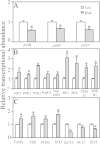Proteomic analyses bring new insights into the effect of a dark stress on lipid biosynthesis in Phaeodactylum tricornutum
- PMID: 27147218
- PMCID: PMC4857112
- DOI: 10.1038/srep25494
Proteomic analyses bring new insights into the effect of a dark stress on lipid biosynthesis in Phaeodactylum tricornutum
Abstract
Microalgae biosynthesize high amount of lipids and show high potential for renewable biodiesel production. However, the production cost of microalgae-derived biodiesel hampers large-scale biodiesel commercialization and new strategies for increasing lipid production efficiency from algae are urgently needed. Here we submitted the marine algae Phaeodactylum tricornutum to a 4-day dark stress, a condition increasing by 2.3-fold the total lipid cell quotas, and studied the cellular mechanisms leading to lipid accumulation using a combination of physiological, proteomic (iTRAQ) and genomic (qRT-PCR) approaches. Our results show that the expression of proteins in the biochemical pathways of glycolysis and the synthesis of fatty acids were induced in the dark, potentially using excess carbon and nitrogen produced from protein breakdown. Treatment of algae in the dark, which increased algal lipid cell quotas at low cost, combined with optimal growth treatment could help optimizing biodiesel production.
Figures




Similar articles
-
[Biodiesel from microalgae: ways of increasing effectiveness of lipids accumulation by genetic engineering methods].Tsitol Genet. 2013 Nov-Dec;47(6):30-42. Tsitol Genet. 2013. PMID: 24437196 Review. Russian.
-
Gene regulation of carbon fixation, storage, and utilization in the diatom Phaeodactylum tricornutum acclimated to light/dark cycles.Plant Physiol. 2013 Feb;161(2):1034-48. doi: 10.1104/pp.112.206177. Epub 2012 Dec 3. Plant Physiol. 2013. PMID: 23209127 Free PMC article.
-
The role of diatom glucose-6-phosphate dehydrogenase on lipogenic NADPH supply in green microalgae through plastidial oxidative pentose phosphate pathway.Appl Microbiol Biotechnol. 2018 Dec;102(24):10803-10815. doi: 10.1007/s00253-018-9415-5. Epub 2018 Oct 23. Appl Microbiol Biotechnol. 2018. PMID: 30349933
-
Effects of outdoor cultures on the growth and lipid production of Phaeodactylum tricornutum using closed photobioreactors.World J Microbiol Biotechnol. 2016 Aug;32(8):128. doi: 10.1007/s11274-016-2089-1. Epub 2016 Jun 23. World J Microbiol Biotechnol. 2016. PMID: 27339309
-
Engineering fatty acid biosynthesis in microalgae for sustainable biodiesel.Curr Opin Chem Biol. 2013 Jun;17(3):496-505. doi: 10.1016/j.cbpa.2013.04.007. Epub 2013 May 14. Curr Opin Chem Biol. 2013. PMID: 23683348 Review.
Cited by
-
Comparative Proteomic Analysis of the Diatom Phaeodactylum tricornutum Reveals New Insights Into Intra- and Extra-Cellular Protein Contents of Its Oval, Fusiform, and Triradiate Morphotypes.Front Plant Sci. 2022 Mar 21;13:673113. doi: 10.3389/fpls.2022.673113. eCollection 2022. Front Plant Sci. 2022. PMID: 35386671 Free PMC article.
-
A 2D-DIGE-based proteomic analysis brings new insights into cellular responses of Pseudomonas putida KT2440 during polyhydroxyalkanoates synthesis.Microb Cell Fact. 2019 May 28;18(1):93. doi: 10.1186/s12934-019-1146-5. Microb Cell Fact. 2019. PMID: 31138236 Free PMC article.
-
Assessment of heavy metals and environmental stress conditions on the production potential of polyunsaturated fatty acids (PUFAs) in indigenous microalgae isolated from the Gulf of Mannar coastal waters.Environ Monit Assess. 2024 Feb 24;196(3):301. doi: 10.1007/s10661-024-12447-y. Environ Monit Assess. 2024. PMID: 38400851
-
Changes in the fucoxanthin production and protein profiles in Cylindrotheca closterium in response to blue light-emitting diode light.Microb Cell Fact. 2018 Jul 9;17(1):110. doi: 10.1186/s12934-018-0957-0. Microb Cell Fact. 2018. PMID: 29986707 Free PMC article.
-
Regulation of Carbon Metabolism by Environmental Conditions: A Perspective From Diatoms and Other Chromalveolates.Front Plant Sci. 2020 Jul 16;11:1033. doi: 10.3389/fpls.2020.01033. eCollection 2020. Front Plant Sci. 2020. PMID: 32765548 Free PMC article. Review.
References
-
- Sivakumar G. et al. Integrated green algal technology for bioremediation and biofuel. Bioresour. Technol. 107, 1–9 (2012). - PubMed
-
- Ho S. H., Ye X. T., Tomohisa H., Jo S. C. & Akihiko K. Perspectives on engineering strategies for improving biofuel production from microalgae—A critical review. Biotechnol. Adv. 32, 1448–1459 (2014). - PubMed
-
- Chisti Y. Biodiesel from microalgae. Biotechnol. 25, 294–306 (2007). - PubMed
-
- Song M. M., Pei H. Y., Hu W. R. & Ma G. X. Evaluation of the potential of 10 microalgal strains for biodiesel production. Bioresour. Technol. 141, 245–251 (2013). - PubMed
Publication types
MeSH terms
Substances
LinkOut - more resources
Full Text Sources
Other Literature Sources

